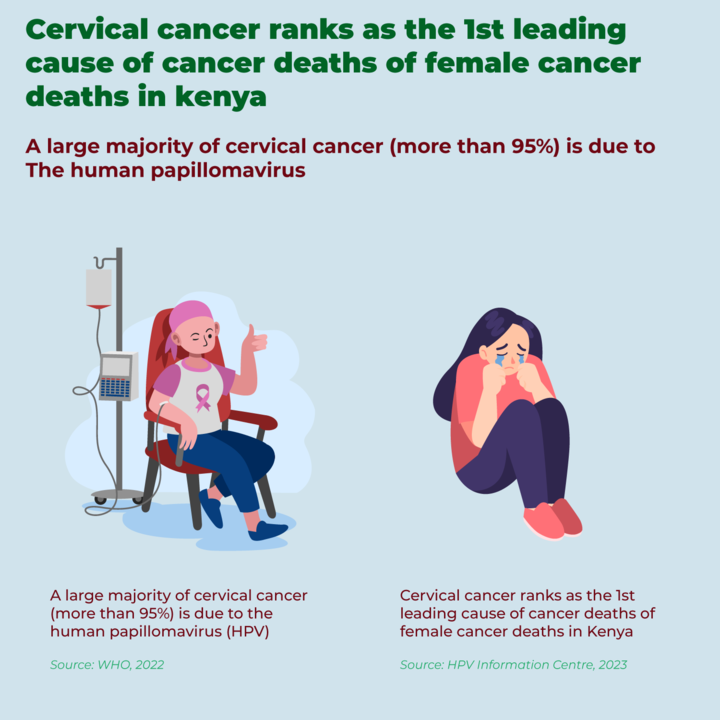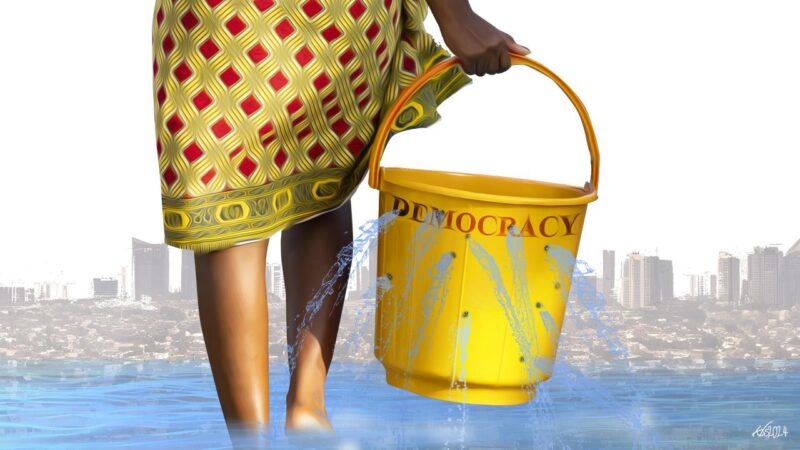When the human papillomavirus vaccine was introduced in Kenya in 2019, it presented an opportunity to deal a death blow to cervical cancer, the second most frequent cancer among Kenyan women (after breast cancer), and the leading cause of cancer deaths among women in Kenya.
The human papillomavirus (HPV) accounts for 99.7% of all cervical cancer cases, and two strains of the virus – HPV 16 and 18 – are among the vaccine-preventable subtypes contributing to over 70% of all cervical cancer cases. Together, HPV subtypes (strains) also contribute to other cancers: 91% anal cancer, 70% oropharynx ( throat) cancer, 75% vagina and vulva cancer in women and 63% penile cancer in men.
Globally, the first HPV vaccine became available in 2006. In 2019 after a pilot in Kitui County, Kenya rolled out the vaccine nationwide as part of the routine immunisation schedule for girls aged 10 – 14 years, with a target uptake of 80%.
While acceptance for the vaccine during the pilot phase was 85%, the uptake of the vaccine since then has been suboptimal with only 29% of girls getting the first dose and only 44% getting the second dose.
The rollout of the vaccine faced opposition from a section of doctors allied with the Kenya Catholic Doctors Association who opposed the vaccine on grounds of safety and morality as HPV is transmitted through sexual contact and was contrary to the church teachings which promote abstinence. Early adolescence is considered the optimal age of vaccination to prevent possible HPV infections as numerous studies that shown that early sexual debut (sexual intercourse at or before the age of 15 years ) is common, as the high number of teenage pregnancies (over 13,000 girls dropping out of school annually) and the the rise in the number of new HIV diagnoses among adolescents indicates. The early sexual debut (ESD) is most likely to be involuntary, forced, coerced, or unplanned and is, therefore, more likely to occur without the use of condoms or other modes of contraception, which increases the risk of HIV/STIs, unplanned pregnancies and raises the risk of HPV infections.
The then Health Cabinet Secretary Sicily Kariuki responded to the doctors’ concerns and assured them that the government would not introduce something harmful to its citizens.
“The HPV vaccine is not new and has undergone the requisite research by the WHO and I would therefore like to appeal to sections of Kenyans to stop sensationalizing this important issue.
“No government, anywhere in the world, would jeopardise the health of its citizenry by introducing a countrywide initiative which has not undergone the necessary research and peer review,” she observed.
During the launch of the vaccine, Dr Rose Jalang’o of the National Vaccines and Immunisation Programme said the human papillomavirus (HPV) vaccination would target adolescent girls aged 14 years and thereafter continue vaccination routinely targeting those aged 10 years.
“Since HPV vaccines are prophylactic, the largest impact of vaccination on the incidence of cervical cancer is expected to result from high coverage of young adolescent girls before first sexual contact,” Dr Jalang’o noted.
Cervical cancer is the second most common cancer in women aged 15 years to 44 years.

Every year, 5,250 women in the country are diagnosed with the disease, and about 3,286 cervical cancer deaths occur annually. At the same time, 10.3 million women aged 15 years and above are at risk of developing the disease. The HPV vaccine was projected to reduce the incidence of cervical cancer from an expected increase of 7,057 cases per year with 4,869 (69 per cent) annual deaths by 2025.
The HPV vaccine rollout coincided with the beginning of the COVID-19 pandemic in 2020, which itself was rife with misinformation. Due to its scale across the globe, fighting misinformation about the pandemic was prioritised and little effort was put into debunking the misinformation about the HPV vaccine. There was barely any community engagement to create awareness of the vaccine, educate communities and debunk the misinformation that had taken root.
Research published in March 2023 on the challenges affecting the uptake of the HPV vaccine highlighted misinformation as a key challenge that contributed to and worsened vaccine hesitancy and refusal. The researchers noted that “vaccination in Kenya has a fake news problem.”
Community health volunteers who were mobilising parents and guardians to take their girls for vaccination came face to face with vaccine hesitancy, fueled by what people had heard from various sources. One parent told Winnie Adera, a community health volunteer based in Kakamega, that a priest had told their congregation not to take girls for vaccination, quoting a misleading article that claimed the vaccine contained contraceptives.
‘The parents believe all sorts of things about how the vaccine works and the motivation of the government. It is very challenging to convince some of them, but we keep doing outreach and creating awareness on its importance with some level of success,’’ said Adera.
One of the contentious issues was the vaccination of girls aged 10-14 years. HPV is transmitted during sex, so doctors affiliated with the Kenya Catholic Doctors Association said it was unnecessary and morally inappropriate to vaccinate girls, and added that vaccinating them would encourage sexual activity. The other claim was that the vaccine would affect the fertility of girls, keeping them from ever having children in adulthood.
Why it’s best to vaccinate girls
The truth of the matter is that vaccination against HPV should ideally occur prior to the onset of sexual activity because it offers a defence against the cancer-causing strains of the virus before a person is exposed to it.
According to Dr Angela Migowa, a paediatrician and assistant professor at Aga Khan University, since HPV has been directly linked to cancer and is spread through sexual contact, prevention is better than cure. She adds that vaccination is key in mitigating the cancer-causing effects of HPV 16 and 18.
In Kenya, where a population of 16.8 million girls and women aged 15 years and older are at risk of developing cervical cancer if exposed to cancer-causing strains, estimates published in March 2023 indicate that every year 5,236 women are diagnosed with cervical cancer, the second most frequent cancer among women after breast cancer. Further, 3,211 women die from the disease, which is the leading cause of cancer deaths among women in the country.
Nearly one in 10 women (9.1%) are estimated to harbour HPV-16 or 18 infections at any given time, and 63.1% of invasive cervical cancers are attributed to these two strains, which can be vaccinated against and treated, thus greatly reducing the incidence of cervical cancer. Therefore, it is best to offer girls and women a defence before they are exposed to the virus.
“The opportune time is before sexual debut, that’s why early vaccination is proposed. You can start as early as nine years for both boys and girls, even though in Kenya the focus is more on girls because of the worrying incidences of cervical cancer. Boys need the vaccine too to protect them from penile cancer,” says Dr Migowa.
In addition, the vaccination of boys is important because of the role men play as asymptomatic carriers of the virus, meaning they rarely suffer from the infection but they can transfer the virus to women.
The HPV vaccine works by training your immune system to recognise and fight the human papillomavirus (HPV). The vaccine contains surface identifiers of the virus, which are unique to HPV, and through the vaccine, via an injection, your natural defence/immunity develops antibodies against the virus. These antibodies stay in your body, ready to defend you against the real HPV if you come into contact with it. As a result, the vaccine protects you from developing HPV-related diseases, including certain types of cancer.

Getting vaccinated before you’re exposed to HPV is the most effective way to prevent infection and the potential health problems it can cause. It’s an essential tool in reducing the risk of cervical cancer and other HPV-related diseases.
“This then ties in with the issue of age. The opportune time to introduce this vaccine is before the person of interest has any contact with the virus because we don’t want the virus to get into any of their cells and cause uncontrolled multiplication,” says Dr Migowa, adding that while individuals between the ages of 26 and 45 can also get the vaccine, they should consult their doctors to make sure they have not been exposed to the virus before they get the vaccine.
Vaccine effectiveness
The KEN SHE study conducted in Kenya and published early this year revealed that a single-dose HPV vaccine is highly effective in preventing persistent infections of the virus over three years. Bivalent vaccines, which protect against two subtypes of HPV, have a 98% efficacy, while the nonavalent vaccine, which protects against nine strains including those that cause cervical, vulva, vaginal and anal cancer, has an efficacy of 96%.
More than 98% of recipients develop an antibody response to the HPV types covered by the vaccines within one month after completing the series, and the effectiveness of the vaccine remains above 90% with no waning of immunity through at least 10 to 12 years after immunisation.
Gardasil 9, the nonavalent vaccine, protects against nine different HPV subtypes, including those responsible for the majority of cervical cancers and genital warts. It is administered to both boys and girls in a series of two or three doses depending on the recipient’s age. For example, individuals aged 9 to 14 receive a two-dose series, with the second dose given six to 12 months after the first. For those aged 15 to 26, a three-dose series is recommended, with the second dose given two months after the first, and the third dose given six months after the first.
Cevarix is the bivalent vaccine which protects against HPV 16 and 18 responsible for a significant portion of cervical cancer. It is primarily recommended for adolescent girls and young women as a preventive measure against cervical cancer and is typically given in two or three doses depending on the age of the recipient. Like Gardasil, Cervarix is administered in a series of injections with a typical dosing schedule involving three doses — the second dose is given one month after the first and the third dose is administered six months after the first.
HPV and cervical cancer
When HPV enters the body through sexual contact, during vaginal, anal or oral sex, it infects the outermost cells on the skin and mucous membranes in these areas. In some cases, the virus can make these infected cells change and grow abnormally. Over time, these changes can lead to the development of pre-cancerous cells. If the pre-cancerous cells are not detected and treated, they can become cancerous. This means they start growing uncontrollably and invading nearby tissues. If not caught and treated early, cancer cells can spread to other parts of the body, causing more serious health problems.
Dr Edward Sang, a gynaecologist and oncologist, explained that while not all HPV infections lead to cancer, as most HPV infections go away on their own without causing any issues, it is important for people to have regular check-ups and screenings.
“The HPV vaccination can help prevent any potential problems early, reducing the risk of cancer. Since the vaccine is readily available in Kenya, we can reduce the numbers of cervical cancer incidences by getting vaccinated,” he said.
Dr Sang recommends that women go for regular Pap smears, a screening test for precancerous and cancerous cells in the cervix, and urges those with other pre-existing conditions such as people living with HIV and other forms of depressed immunity to get the vaccine as it is beneficial to them.
Addressing misinformation
In December 2022, the Clinton Health Access Initiative launched a 100-day HPV immunisation campaign to boost the uptake of the vaccine. They published a report that showed that first dose coverage increased from 56% at the end of November 2022 to 71% at the end of February 2023, while the second dose coverage increased from 27% to 38% in the same period.
The lower uptake of the second dose is usually due to the effects of the immune response after receiving the first dose of the vaccine. Some people have a reaction such as pain, reddening, or swelling at the site of injection, or experience fever. This is not unique to the HPV vaccine; it happens with other vaccines, but these reactions play a role in the low uptake of the second dose because, without the right information, they further fuel misinformation. A study by Kemri published in April 2023 found that a single-dose HPV vaccine is effective over three years.

Eric Mugendi, a fact-checker with expertise on misinformation on health issues, says that a lot of misinformation comes from well-meaning people who think they are spreading genuine and credible information, but there are also people who spread false information with a malicious agenda. For this reason, people countering misinformation should amplify the science and facts, showing the benefits of the vaccine in improving the quality of life and showing how it has worked by decreasing incidences of disease.
“The success of campaigns like the polio and COVID-19 vaccine campaigns can be attributed to information that amplified the real consequences of not vaccinating against these types of diseases,” says Mr Mugendi, adding that comparing the deaths of people who were vaccinated and those of people who hadn’t been vaccinated made it clear that the vaccine was working and reducing the number of deaths.
Mr Mugendi says that fighting vaccine misinformation requires word of mouth from people we know and trust.
“This improved vaccine uptake during the Covid pandemic as loved ones shared and encouraged their family members and friends to go for the vaccine as opposed to saying it is the government that wants you to get the vaccine,” he explains, adding that religious leaders can also champion communication about the vaccine because their audiences trust them.
Public service announcements and advertisements on television and radio also work, as do forums with knowledgeable medical practitioners where people can ask questions and learn the benefits of getting the vaccine and the consequences of not getting the vaccine.
Social media platforms like Facebook and Twitter, and messaging apps like WhatsApp have been predominantly used to spread health and vaccine misinformation, but Mr Mugendi says there’s currently no way to report health misinformation specifically because platforms haven’t identified it as deserving of its own category when people are reporting harmful content online.
“The best way would be to give people a way to report misinformation. As it is now, you report harmful or potentially harmful content like hate against specific groups of people. The platforms haven’t identified health misinformation as something deserving of its own category when people are reporting harmful content online. Consequently, it becomes really difficult to get posts or messages spreading false information to be taken down as someone could easily say this is my opinion and the way opinions are featured on these platforms, it becomes really hard to get anything that could cause harm to be taken down quickly before causing a significant amount of harm,” he says.
To deal with this, the World Health Organisation uses a social listening tool to find conversations on emerging public health crises and threats and puts out a report with factual information about the issue to counter false information.
While fact-checking has been beneficial in countering misinformation online, it’s only created a means to address individual posts rather than systemic problems when it comes to platforms like X (formerly Twitter) where verified accounts (with a blue tick) get more visibility.
To address such, Mr Mugendi recommends responding to the motivations behind spreading false information and removing the ability to monetise false information by slowing down the flow of such information and holding those who post misinformation accountable so that they don’t get away with it.
Further, when discussing how vaccines work, Mr Mugendi says technical terms and jargon should be avoided, and experts should use analogies that communities can relate to, as well as testimonials, to breach psychological distance, especially if they have not seen or experienced consequences of the disease.
Compliance by people when it comes to vaccine uptake should be linked to the benefits and the protection it offers communities and not government-issued instructions.
“The reason why people believe misinformation on vaccines is because of the relationship we have to the institutions behind these vaccines, the companies, the agencies and the government agencies, especially, that are doing the work of trying to vaccinate people against diseases.
“The language in the publicity material should be simple, but not so simple that it loses meaning. It should include a lot of images and visual representations of exactly what you’re trying to communicate so that people who may not necessarily understand the language are still able to follow because they can look at the image,” Mr Mugendi concludes.
Campaigns to promote the uptake of vaccines in the face of misinformation or disinformation require an understanding of the community and their beliefs and perceptions, rather than dictating what they should do. Understanding their perceptions and needs can help shed light on the truth about vaccines without disrespecting their concerns. Building trust by working with the communities through their leaders can improve the uptake of vaccines by addressing concerns that could open up ways for misinformation to breed and spread.
–
This story was written and produced as part of a media skills development programme
delivered by the Thomson Reuters Foundation. The content is the sole responsibility of the author and the publisher. The story has been produced with the support of the Africa Women Journalism Project (AWJP)








